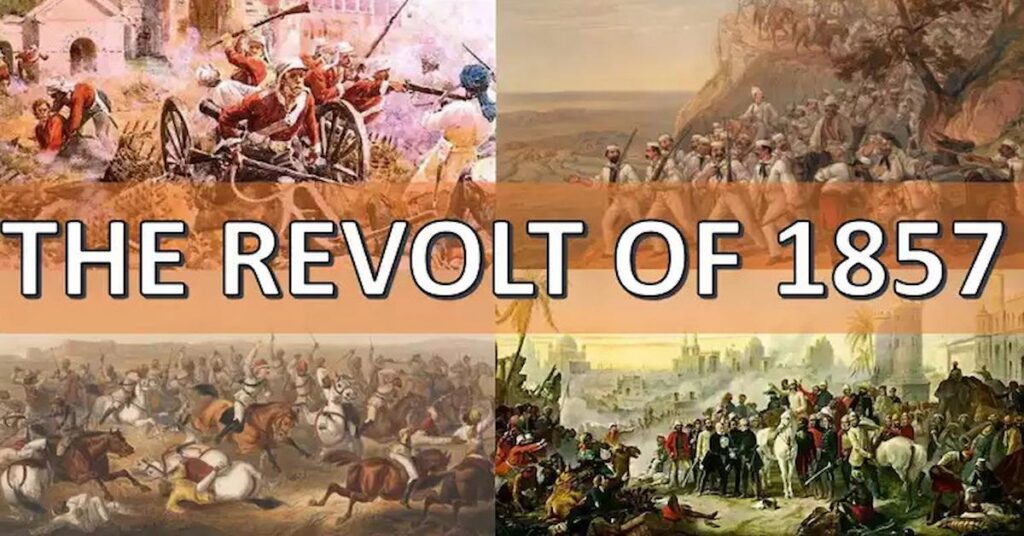The Great Revolt of 1857
In the Great Revolt of 1857, British rule witnessed the biggest challenge to its existence. Initially, it began as a mutiny of Bengal presidency sepoys but later expanded to other parts of India, involving large numbers of civilians, especially peasants. This was the first major revolt of armed forces accompanied by civilian rebellion. The revolt ended the role of the East India Company and the governance of the Indian subcontinent was taken over by the British Crown.


British India: An Annexation Policy
In the 1840s and 1850s, more territories were annexed through two major policies. They are the subsidiary alliance, the doctrine of lapse.
The Doctrine of Paramountcy
The British claimed themselves to be paramount, exercising supreme authority. New territories were annexed on the grounds that the native rulers were corrupt and inept.
The Doctrine of Lapse
Satara, Sambalpur, parts of the Punjab, Jhansi, and Nagpur were annexed by the British through the Doctrine of Lapse.
The Great Revolt
The precursor to the revolt was the circulation of rumors about the cartridges of the new Enfield rifle. On March 29th, a sepoy named Mangal Pandey assaulted his European officer. His fellow soldiers refused to arrest him when ordered to do so. Mangal Pandey, along with others, was court-martialled and hanged. This only made anger worse, and in the following days, there was an increased incidence of disobedience. Burning and arson were reported from the army cantonment, Lucknow, and Meerut.
The Great Rebellion
The Indian Rebellion of 1857 was also called India’s First War of Independence, the Great Rebellion of India. The Great Rebellion of India included the Sepoy Mutiny and the Indian Mutiny of 1857-1858 rebellion. It was a very bloody and violent series of battles and uprisings against the British presence in India. British forced to call in extra troops from England to quell uprisings. It began an era of extreme racial distinctions between the British and Indians and social segregation. British enjoyed a life of opulence and luxury. It Mixed a race of British and Indians who were not considered racially “pure” and were looked down on
Civil Rebellion
The mutiny was equally supported by an aggrieved rural society in north India. Sepoy Rebellion India working in the British army were in fact peasants in uniform. The first civil rebellion broke out in parts of the North-Western Providence and Oudh. These were the two regions from which the sepoy rebellion India was predominantly recruited. Many Zamindars and Taluqdars were attracted to the rebellion as they had lost their various privileges under the British government.
Prominent battles With the British
The mutiny provided a platform for aggrieved kings, nawabs, queens, and zamindars to express their anger. Nana Sahib, the adopted son of the last Peshwa Baji Rao II, provided leadership in the Kanpur religion. He has been denied a pension from the company. Begum Hazrat Mahal in Lucknow and Khan Bahadur in Bareilly took command of their territories.
Rani Lakshmi Bai, who assumed the leadership in Jhansi, said that Dalhousie, the governor-general of Bengal, had refused her request to adopt a son as her successor after her husband died. The kingdom was annexed under the Doctrine of Lapse. Rani Lakshmi Bai battled the mighty British army until she was defeated.
Failure Causes
One of the important reasons for the failure of the rebellion was the absence of a central authority. There was no common agenda that united the individuals and the aspirations of the Indian princes and the various other feudal elements fighting against the British. In the end, the sepoy rebellion in India was brutally suppressed by the British army. The rebel leaders were defeated due to a lack of weapons, organization, discipline, and betrayal by their aides. Delhi was captured by the British troops in late 1857.
India Becomes A Crown Colony
British people were shocked by the events of 1857. The British parliament adopted the Indian Government Act in November 1858, and India was pronounced as one of the many crown colonies to be directly governed by the parliament. The responsibility was given to the parliament by the cabinet, designated as the secretary of state of India. The transfer of power from the East India Company to the British Crown also meant that there was a regular parliamentary review of Indian affairs.
Conclusion
British rule and its policies underwent major changes after 1857. Queen Victoria proclaimed to the American people that the British would not interfere in traditional institutions and religious matters. The British turned away from Rajputs, Brahmins, and Northern Indian Muslims and looked toward non-Hindu groups like Sikhs and Pathans. The British also exploited the caste, religious, Hinduistic, and regional differences in Indian society through what came to be known as the divide-and-rule policy.
